|
Artichokes Cynara scolymus
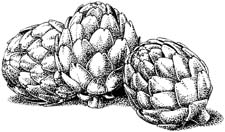
Introduced to California in 1920's by Italian farmers.
Culture: Sow the seeds 1/4" in 4" pots in late
January. Optimum germination at 75° in 10-12 days. Transplant 8
weeks later or until soil temperature is 50°, spacing 24" apart
in rows 3' apart. They are usually grown as a perennial and
require 250 hours of temperatures below 50° to induce flowering.
In late October cut plants to 8-10" above ground and cover with
straw. Uncover in early April. The new plants will be rooted
offshoots of the parent plant.
Diseases: relatively disease free
Pest: aphids
Asparagus Asparagus officinalis
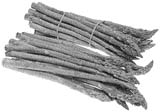
Grow in well drained soil, pH 6.0 to 7.5. Can be grown from
seed or buy 1 year old crowns. Plant when soil temps have
reached 50°F. Dig a furrow no deeper than 5 to 6 inches. After
planting, back fill the furrow to its original soil level. .
Spears should emerge within one week in moist soils. Do not
harvest the asparagus during the planting year. Spears will be
produced from expanded buds on the crown. As the spears elongate
and reach a height of about 8 to 9 inches, the tips will open.
The spear will become woody to support the small branchlets that
become ferns. The ferns produce food for the plant and then move
it down to the crown for next year's spear production.
Sweet Bell Peppers Capsicum annum
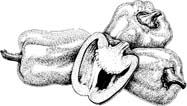 Start seeds about 8 weeks before last frost date. Seed
germination is sporadic and takes anywhere form 8 to 25 days.
Peppers are slow growers. Plant in out in full sun after all
danger of frost and soil temps are 60°F or above. A good seaweed
or organic tomato fertilizer is recommended. Most peppers can be
eaten at any time from green to fully ripened, depending on your
taste.
Broccoli Brassica oleracea
 Broccoli does best between 40 ° and 70° F. Plant in late
summer so it will mature in the fall. Below 25°F can damage the
plant. Start 10 or so weeks indoors so broccoli can mature
before frost.
Cabbage Brassica oleracea
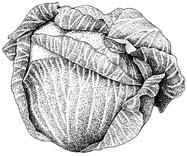 Cabbage grows best planted in time to head when daytime
temperatures are under 80 degrees F. High fertility, improper
water conditions and heat can cause loose, puffy heads. Plant
your seeds indoors 1/4" to 1/2" deep, 6 to 8 weeks before
setting outside. Germination is 7 to 10 days at 70 to 85 degree
F. Plant them 24" apart outside in garden. Spring planting
should occur as soon as soil can be worked, and fall planting
done around June or July
Carrots Daucus carota var.
sativus
 Best soil temps are 50-60°F. Carrot plants thrive in
deep, loose, well-drained soil. Carrot plants do not grow well
in strongly acid soils; therefore, a pH range of 6.0 to 6.8
should be maintained for best results. Direct seed carrots into
a well-prepared soil early in the spring. Suggested planting
depth is 1/4 inch deep in rows spaced 12 to 18 inches or more
apart depending on the method of cultivation used. It is
important to avoid crusting of the soil around the seed-bed.
Covering the seed with vermiculite or fine compost and keeping
the soil evenly moist until the seedlings have emerged will help
prevent this problem. After the seedlings have emerged, thin
them to one inch apart. When the tops of the carrots grow
thicker, thin them to about two to three inches apart. Harvest
can begin when carrots are finger size. In general, the smaller
carrots are juicier and more tender.
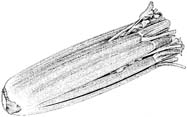 Celery Apium
graveolens
Soil should 6.5-7.0 pH with as much manure as you have. Dig a
trench 15" wide, 12" deep. Add manure and soil back to 3". Water
copiously. Feed with liquid manure during the summer. When the
plants are about 12" high, strip off any side stalks and tie the
plants with string or surround them with newspaper. Fill the
trench with soil. Every three weeks draw more soil over the
stems (preferably after rain), being careful to keep soil from
falling into the tied plants. By September just the leaves
should be poking out of a mound.
Chile Peppers C.chinense; C.baccatum;
C.frutescens; C.annuum
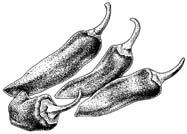 Germinate in seed mix 80°F about 8 weeks before you last
frost date. Seeds can take up to 25 days or so to germinate.
Some varities need bottom heat of 85° or so to germinate. When
plants get 3 sets of true leaves transplant into 4" pots. Wait
to plant out until soil temps are 60°F or above. Plant
transplants in full sun with compost, composted manure and a
good organic fertilizer is recommended, in a well drained soil
mix. Chiles can also be grow in containers and overwintered for
planting out the next year. The do go dormant and will drop
leaves, decrease water and do not fertilize until the spring.
Cut back any some of the dead branches before planting out.
Pests: aphids, white fly, scale
Corn Zea mays
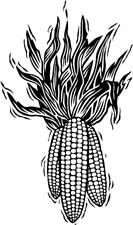 Wait until soil temps are 65° before planting seeds 5-6 seeds
per foot, 1-2" deep. Germintion in 7-10 days, thin to 8". Corn
is wind pollinated and should be grown in 4 rows or more for
best pollination. Compost and manures are good as soil
additives. Most corn is bred to produce 2 ears, sometimes 3.
Pests: Corn borers can be controlled with
pyrethrin/rotenone. Some people have had luck applying a small
drop of oil when the tassels are starting to appear.
Harvest: When tassals start to brown and dry,
eat ASAP for the best flavor or store at 34°.
Pole Beans Phaseolus
vulgaris
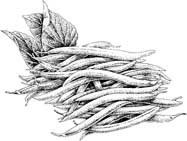 Optimum soil temp is 65°. Grow
vertical up poles or trellises.
Plant 1-2" apart. Water well as roots are shallow and can use up
to 1/4" of water on hot days. Mulch around the roots to retain
water.
Pests: Mexican bean beetles controlled by
rotenone
Harvest: Beans are ready about 2 weeks after
they flower.
Lettuce Lactuca sativa
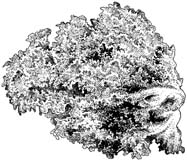 Most are a hardy cool season crop and can be grown as soon as
soil can be worked. Most do best when temperatures are 60-70°
and can germinate in 40° soil. A cold frame and cold hardy
varieties can stretch the growing season into the winter. Days to
germination 2-15. Direct sown 1" apart in rows 18" apart. Cover
seeds lightly and after true leaves set thin to 18".
Pests: Aphids control with washing off with
spray of water or insecticidal soap.
Mushrooms
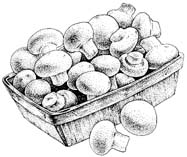 Mushrooms should be grown from kits so you know what variety
you are getting and don't risk accidental poisoning. Kits can be
purchased with logs that have been impregnated with spawn or
with plugs that you can put into your own log. Varities shitake,
portabella, button to name a few. Complete instructions come
with the kit.
Onions Allium
 Plant in the fall, individual bulbs 6" apart with the tip of
the bulb even with the surface of the soil. In the spring it
will send up leaves and be sure to pick any seed head that start
to form. Harvest in July or August. Dry bulbs and store dry in
mesh bags or hang.
Peas Pisum sativum
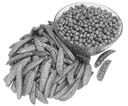 Cool season crop and grow well in most any well drained soil
in full sun. Plant as soon as soil can be worked. Sow seeds 1"
apart and 1" deep. Thinning is not necessary. Optimal temps are
50-77° with emergence in 6-14 days. Grow verticle on poles or
trellis.
Pests: Pea aphids controlled with pyrethins or
rotenone
Potatoes Solanum tuberosum
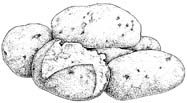 Grow potatoes in loose well drained soil planted 3 weeks
before last frost date. Plant 4-6" deep 12" apart. Leave 3 eyes
per piece. Water on a regular basis and let soil dry slightly
between waterings. The addition of bone meal is recommended.
Harvest: When leaves start to die and potatoes
are a good size. Standard potatoes varieties yield 10 times the
amount originally planted and fingerlings 15 times. Potatoes
should be left in the hill 2 weeks after the vine has died, this
allows time for their skins to set increasing storage time.
Mulching the plant early in the season or at this time will
protect them from sun scald. Store in dry location as cool as
possible without freezing.
Radish Raphanus sativus
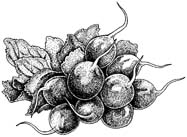 Best sown in spring or late summer to mature during cooler
temperatures. Sow outdoors March through August, 1/2" deep 1/2"
apart. Days to emergence are 4-11 with the optimum temperatures
55-80°. Thin to 1-1/2" apart, with ample water supply since they
have a shallow root system.
Pests: flea beetles controlled with pyrethrins.
Spinach Spinacia oleracea
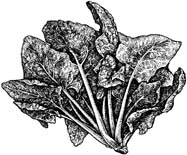 Fertile rich soil 6.5-7.5 pH. Grows best in cooler
temperatures 60-65°. Blood meal or fish meal is recommended for
fertlizing. Soil temps 50°, seeds sown 1/2" apart and 12" apart.
Germination in 6-21 days with the optimum temperature of 55 to
65°.
Harvest: When young 3-4" stored at 32°.
Pests: Spinach leaf miners, destroy any leaves
and keep area well weeded.
Squash Cucurbita spp
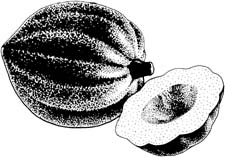 Grows best in good fertile soil with as much sunshine and
warmth they can get. Direct sow in soils at least 60° 1 1/2"
deep with bush varities 20" apart. Squash does not like to be
transplanted. If starting early start in peat pots so you will
not disturb the roots when transplanting. Squash bear both male
and female flowers. The male being the first to flower, the
female after. The need good pollinators to get a good fruit set.
Pests: Cucumber beetles, vine borers, squash
beetles controlled with pyrethrins/rotenone
Harvest: The young are the most flavorful and
tender
|